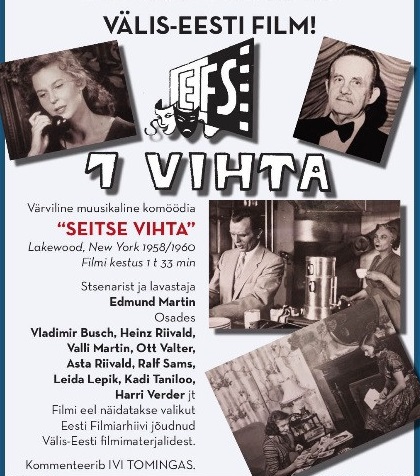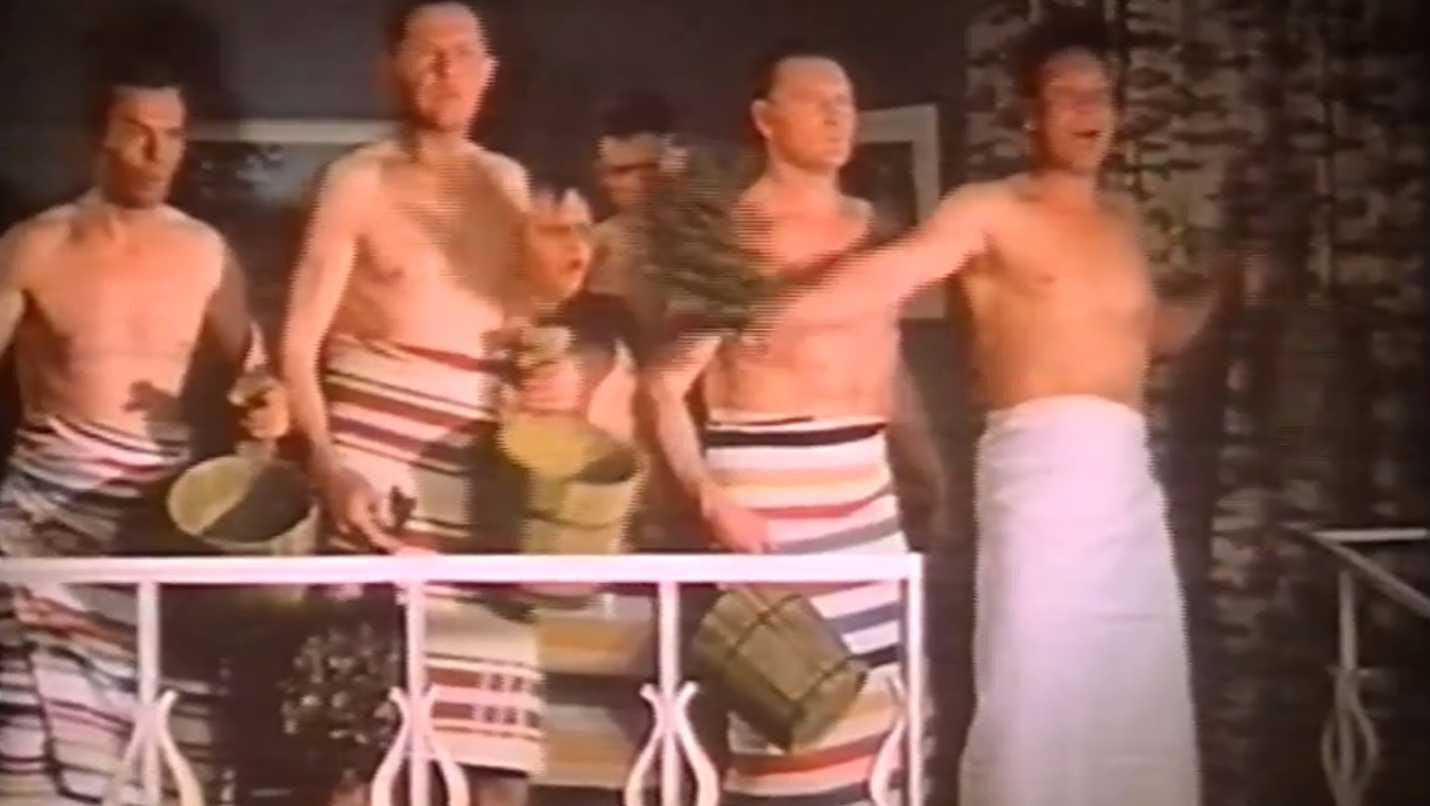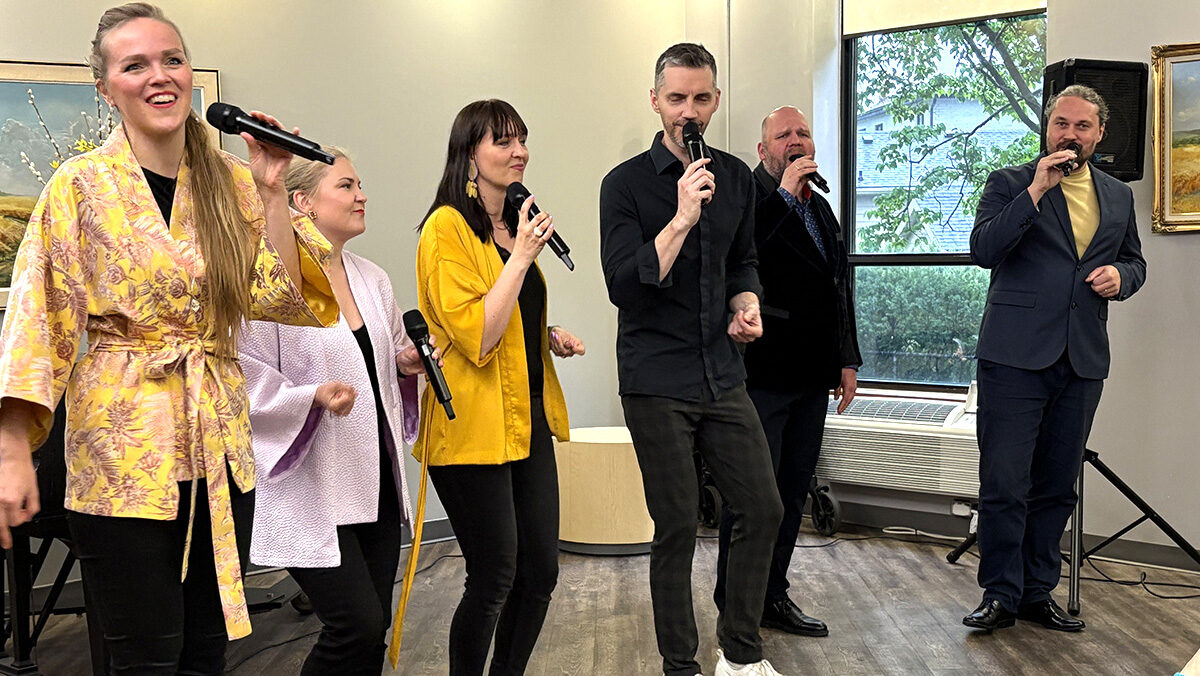Emotions such as photos of family gatherings, parties, and the ways our communities have treated homesickness. Among the most elaborate records of this brighter side of diaspora life is the musical comedy film Seitse vihta, which I was recommended to watch one day.
Within a few minutes of watching, it was apparent that, despite the title, we weren't in Estonia anymore. The giveaways were the spaced out suburban homes and the chain link fence that crop up in the first scene of the film. We're also in a different era—the 1950s to be specific. Loose fitting suits, curls and full skirts, cars with fins, cameras with flashing bulbs. The whole movie has many objects that take us back to that time.
Seitse vihta starts on an autumnal Saturday afternoon in a small town, as an Estonian man, Sergeant Major Juhan Lõhmus (played by Ott Walter) is unpacking groceries. He's approached by Maali Ojamaa (Polli Mõtus), who asks about the gold-decorated drinking glasses he's showing off. Juhan is preparing for a “sauna juubel”that night with Lieutenant Ilmar Ratas (Heinz Riivald) and their friends—celebrating what seems to be their 100th such party.
Together, they steal all of the men's clothing and refreshments. Upon leaving the saun and discovering that everything is gone, the men rush back home, disoriented, with towels around their waists.
Getting the party prepared isn't without its hiccups. Sirje (played by Valli Martin, the film's choreographer and wife of director Edmund Martin) lets her husband Ilmar go to this party, but Juhan isn't able to get the same permission. Ilmar's friends get ready for their party with a keg of beer and a savoury rukkileib kringel with cut up egg and kilu (sprat fish) on top. They bundle together branches for the seven vihad they use in the saun, and their other friend, Corporal Uduste, is decorating the wall inside the saun building.
But once the party is underway and the men are distracted, singing the movie's main theme song in the saun, Sirje and her friends play a prank. Together, they steal all of the men's clothing and refreshments. Upon leaving the saun and discovering that everything is gone, the men rush back home, disoriented, with towels around their waists.
Here they find a roaring party with rahvatants, a full ensemble of musicians, and their missing kringel and beer. The film ends with something akin to a variety show. Comedic musicians Rolli and Arri Jõgimar perform a slapstick musical routine, with a fiddle, a banjo, and mesmerizing bowler hat tricks. At times, the storyline deviates and the movie becomes more like an exaggerated vignette of a time, place, and people.
Over the film's 93 minute runtime, we are introduced to the many Estonians of their neighbourhood, including an aspiring Hollywood actress, a fellow with the nickname Kapsas (“Cabbage”), and a budding romance between two young Estonians, Virve and Jõgis. Maali makes a special trip to speak with Kapsas. Ilmar finds a handwritten note, which triggers memories of meeting Sirje and his time as a soldier. It seems everyone has dreams, social engagements, or an ongoing romance.

The soundtrack, by Jüri Mandre, creates a jubilant aura around a film which, in other ways, appears to have been made with a limited budget. For instance, the open credits were painted on boards and shot with a single camera panning from left to right. Nonetheless, all of the actors and crew involved endeavoured to create an entertaining spectacle.
The characters mix the Estonian language with English words like “hi” and “yes” in dialogue. You'll even hear phrases like “Everything on okay!” (“Everything is okay!”) or “Have a nice time Virvega” (“Have a nice time with Virve”).
The film was directed by Edmund Martin and produced by the Eesti Filmikeskus (Estonian Film Center) in New York. As detailed by Vaba Eesti Sõna newspaper for the director's 90th birthday in January 2000, Martin founded the center after emigrating to the US in 1952. Then, on November 30th, 1958, Seitse vihta premiered at Hunter College in Manhattan. Today, it's part of the film archive of the National Archives of Estonia.
One small, but memorable, aspect of the film is hearing how the characters mix the Estonian language with English words like “hi” and “yes” in dialogue. You'll even hear phrases like “Everything on okay!” (“Everything is okay!”) or “Have a nice time Virvega” (“Have a nice time with Virve”). I'm glad that they didn't edit out this linguistic fusion; a stamp of who we are in the broader Estonian world.
In any case, this fully Estonian language film made in North America is a fine document of Estonian diaspora cultural phenomena. The story and its delivery are certainly of its time, but through it, we can look back at the generations, many of whom are no longer with us, and imagine how they spent time together.
This article was written by Vincent Teetsov as part of the Local Journalism Initiative.




